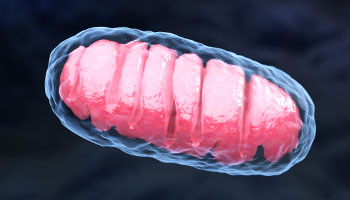HOW CAN WE HELP YOU? Call 1-800-TRY-CHOP
In This Section
MC² Program Energizes Research Between Mitochondrial Disease and Pediatric Cancer

Mitochondria function as the biological batteries that produce energy within our body’s cells.
mccannn [at] chop.edu (By Nancy McCann)
Tapping into the energy of Einstein's equation, E = MC², researchers at Children's Hospital of Philadelphia are joining forces in the newly formed Mitochondria and Cancer Connections (MC²) Research Program.
They aim to reveal the precise biological mechanisms and strategies at play at the edge of cellular life and death. Mitochondrial disease researchers work to nurture energy-deficient cells as they struggle to survive and grow, whereas cancer researchers are driven to understand how to kill aggressively growing cancer cells and prevent their return.
Co-led by geneticist Marni Falk, MD, director of the Mitochondrial Medicine Frontier Program, and neuroscientist Adam Resnick, PhD, director of the Center for Data-Driven Discovery in Biomedicine (D3b), the team looks to leverage their existing centers and knowledge to establish a cutting-edge research initiative that will uncover new insights into disease processes and therapeutics, at the intersection of mitochondrial disease and cancer, starting with a focus on osteosarcoma, the most common cancerous bone tumor among youth.
Yin and Yang: Mitochondrial Disease vs. Cancer
While mitochondria function as the biological batteries that produce energy within our body's cells, those with mitochondrial disease have dysfunctional mitochondria. Their mitochondria fail to produce enough energy for cells to function, causing a plethora of health concerns. While on average, people with mitochondrial disease have 16 major medical problems, cancer is not among them — an observation the team believes is due to cancer's need for functional mitochondria to live and grow.
"We realized there's an inherent difference in survival strategies and death mechanisms between a cell with mitochondrial disease and one with cancer," Dr. Falk said. "These complementary responses represent a basic yin and yang. Ultimately, we aim to steal strategies from cancer to help mitochondrial disease cells grow and function better, while at the same time stealing strategies from mitochondrial disease to slow down cancer. In other words, our basic goal is to learn from the survival strengths and weaknesses of one disease, to shed light on precision treatment strategies for the other. If we're lucky, we'll find therapies for both classes of diseases."
Data, Data, and More Data
MC² is all about gathering, integrating, and analyzing complex data. By enhancing CAVATICA, a data analysis and sharing platform developed by D3b, the MC² team will be able to provide open access to pediatric genomic data and establish a first-of-its-kind multi-omics data dynamic modeling infrastructure. The new platform will integrate, analyze, model, and allow researchers to directly compare deep cell phenotyping data from the genome, transcriptome, metabalome, proteome, and targeted markers of immune function and cell death.
Using osteosarcoma tumor cells from CHOP's biobank and mitochondrial disease patient cells available for research in the CHOP Mitochondrial Medicine program, the team will manipulate the cells' nutrition and stressors to study the ways this influences their survival and function. Then, CAVATICA will be used to collect, integrate, and visualize this high-dimensional data to reveal the opposing cellular processes at work in the survival, growth, stress response, and function of mitochondrial disease and osteosarcoma cancer cells. The MC² team ultimately will use these data to select targeted pharmaceutical and genetic therapies to treat osteosarcoma and mitochondrial disease at both the cellular level and by working with zebrafish animal models of these diseases.
"This work is likely to lead to the creation of a robust informatics resource development to benefit multi-omics modeling in a wide range of future studies across CHOP," Dr. Resnick said, "as well as develop strong preliminary data to support future federal funding and novel therapeutic leads that could translate to precision therapies that ultimately benefit pediatric patients with mitochondrial disease and cancer."
A three-year CHOP research program, MC² was launched in 2021 through the generosity of CHOP supporters Patricia and David Holveck.